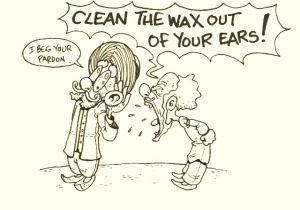
Ear wax, also called cerumen is a water resistant coating in the ear canal that protects the skin of the canal from water damage, infection, trauma and debris. If it accumulates it is usually not noticeable, but can lead to hearing loss as well as pain/infection. Normally it is supposed to migrate from near the ear drum along the canal and fall out of the ear.
Cerumen is a mixture made up of secretions of both sebaceous (oil), dried skin cells, and sometimes hair. It is identified in the ear canal in your doctor’s office with an instrument called an otoscope. It’s appearance and texture vary widely – sometimes it has the appearance and texture of a liquid, and other times it looks like clay or rock.
Causes of ear wax accumulation: Narrowing of the ear canal can make it difficult for the ear wax to fall out of the ear. Skin disorders such as eczema can cause excessive cerumen. Also as people age, they produce less fluid in the cerumen and it gets harder migrates slower out of the ear canal. Epithelial migration can also occur as a result of using cotton swabs in the ears. Q-tips tend to push ear wax deeper into the ear canal and over time can cause complete blockage of the ear canal in some people. Hearing aids, ear plugs and swim molds also after prolonged use can contribute to ceumen accumulation.
Overproduction: Some people produce more cerumen than others and this overcomes the ear canal’s ability to eliminate it.
Symptoms of ear wax accumulation: Hearing loss, earache, ear fullness, itchiness, dizziness, and/or ear ringing.
Removal methods: Ear wax is usually removed with one of three popular methods –medication to break down the wax, irrigation, and manual removal with a small ear spoon to scoop it out.
How to prevent cerumen accumulation: Many people have difficulty preventing ear wax accumulation, especially if they have predisposing conditions such as a narrow ear canal, eczema or produce more was than average. For many patients, topical drops such as mineral oil soaked on a cotton ball and left in the ear for about 10-20 minutes once a week while also not using a hearing aid overnight (if applicable) is helpful.
Routine cleaning of the ears by a healthcare provider every 6-12 months is also helpful to many people. If the wax becomes very difficult to remove, an Ear/Nose/Throat doctor can use a ear microscope and special instruments to help remove it more easily.
This document is for informational purposes only, and should not be considered medical advice for any individual patient. If you have questions please contact your medical provider.
Tags: blocked ears, cerumen, clean ears, cleaning ears, clogged ears, cotton swabs, dirty ears, dizziness, ear ringing, ear wax, ear wax accumulation, ear wax and the elderly, ear wax removal, eczema, itchy ears, narrow ear canals, q-tips, tinnitus
This entry was posted on Wednesday, March 13th, 2013 at 5:11 pm and is filed under Uncategorized. You can follow any responses to this entry through the RSS 2.0 feed. You can leave a response, or trackback from your own site.
